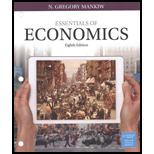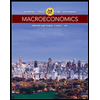
Number of
Answer to Problem 1CQQ
Option “a” is correct.
Explanation of Solution
Option (a):
The person who is not currently at work but who has actively worked during the previous month is referred to as unemployed. Therefore, the number of unemployed is 10. Thus, option “a” is correct.
Option (b):
Here 40 peoples are full-time workers, 20 people work half-time but are referred to full-time workers, 10 are looking for a job,10 would like to work but are so discouraged that they have given up looking for a job, 10 are not interested in working because they are full-time students and 10 are retired. From this category, the number of people who are looking for job (10) is the number of unemployed from the total population of 100. Thus, option “b” is incorrect.
Option (c):
From different category of people according to their employment status, it is found that 10 people are unemployed. Thus, option “c” is incorrect.
Option (d):
40 peoples are included in full-time working category and only 10 peoples are considered to be the unemployed. Thus, option “d” is incorrect.
Concept introduction:
Unemployed: In government statistics, a person who is not currently at work but is available to do work and has actively worked during the previous month is referred to as unemployed.
Want to see more full solutions like this?
Chapter 20 Solutions
Bundle: Essentials Of Economics, Loose-leaf Version, 8th + Lms Integrated Mindtap Economics, 1 Term (6 Months) Printed Access Card
- Critically analyse the five (5) characteristics of Ubuntu and provide examples of how they apply to the National Health Insurance (NHI) in South Africa.arrow_forwardCritically analyse the five (5) characteristics of Ubuntu and provide examples of how they apply to the National Health Insurance (NHI) in South Africa.arrow_forwardOutline the nine (9) consumer rights as specified in the Consumer Rights Act in South Africa.arrow_forward
- In what ways could you show the attractiveness of Philippines in the form of videos/campaigns to foreign investors? Cite 10 examples.arrow_forwardExplain the following terms and provide an example for each term: • Corruption • Fraud • Briberyarrow_forwardIn what ways could you show the attractiveness of a country in the form of videos/campaigns?arrow_forward
 Exploring EconomicsEconomicsISBN:9781544336329Author:Robert L. SextonPublisher:SAGE Publications, Inc
Exploring EconomicsEconomicsISBN:9781544336329Author:Robert L. SextonPublisher:SAGE Publications, Inc Macroeconomics: Private and Public Choice (MindTa...EconomicsISBN:9781305506756Author:James D. Gwartney, Richard L. Stroup, Russell S. Sobel, David A. MacphersonPublisher:Cengage Learning
Macroeconomics: Private and Public Choice (MindTa...EconomicsISBN:9781305506756Author:James D. Gwartney, Richard L. Stroup, Russell S. Sobel, David A. MacphersonPublisher:Cengage Learning Economics: Private and Public Choice (MindTap Cou...EconomicsISBN:9781305506725Author:James D. Gwartney, Richard L. Stroup, Russell S. Sobel, David A. MacphersonPublisher:Cengage Learning
Economics: Private and Public Choice (MindTap Cou...EconomicsISBN:9781305506725Author:James D. Gwartney, Richard L. Stroup, Russell S. Sobel, David A. MacphersonPublisher:Cengage Learning







